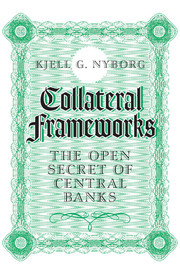Book contents
- Frontmatter
- Contents
- List of Figures
- List of Tables
- List of Exhibits
- List of Examples
- Preface
- Acknowledgments
- 1 Background and Motivation
- 2 Collateral Frameworks: Overview
- 3 Monetary Policy Implementation in the Euro Area over Time
- 4 Evidence on the Production and Usage of Collateral
- 5 Haircuts
- 6 Ratings and Guarantees
- 7 Market and Theoretical Prices
- 8 Collateral “Own Use”
- 9 Non-regulated Markets, Unsecured Bank Debt, and LTRO Uptake
- 10 Market Discipline
- 11 Bailing Out the Euro
- 12 The Endgame of the Euro Crisis
- 13 Restoring Credibility
- 14 The Problem with Collateral
- 15 Concluding Remarks
- Appendix: Haircut and Rating Rules Updates
- References
- Index
12 - The Endgame of the Euro Crisis
Published online by Cambridge University Press: 06 January 2017
- Frontmatter
- Contents
- List of Figures
- List of Tables
- List of Exhibits
- List of Examples
- Preface
- Acknowledgments
- 1 Background and Motivation
- 2 Collateral Frameworks: Overview
- 3 Monetary Policy Implementation in the Euro Area over Time
- 4 Evidence on the Production and Usage of Collateral
- 5 Haircuts
- 6 Ratings and Guarantees
- 7 Market and Theoretical Prices
- 8 Collateral “Own Use”
- 9 Non-regulated Markets, Unsecured Bank Debt, and LTRO Uptake
- 10 Market Discipline
- 11 Bailing Out the Euro
- 12 The Endgame of the Euro Crisis
- 13 Restoring Credibility
- 14 The Problem with Collateral
- 15 Concluding Remarks
- Appendix: Haircut and Rating Rules Updates
- References
- Index
Summary
The endgame of the euro crisis began with the confirmation in the ECB press conference on January 22, 2015, that the Eurosystem would buy sovereign bonds. This was introduced on the back of the ABS and covered bond purchase programs announced September 4, 2014, and discussed in the previous chapter. This combined, or expanded, asset purchase program represents what central bankers refer to as quantitative easing, meaning that the purchases of the assets are financed by the creation of new (electronic) central bank money.
The exact timing relates to an interim opinion by the European Court of Justice on January 14, 2015, regarding the legality of the ECB's Outright Monetary Transactions (OMT) program to buy sovereign bonds of troubled countries (ECJ 2015a). The opinion, issued by Advocate General Cruz Villalón, states that the OMT program is, in principle, within the ECB's mandate. Importantly, the Advocate General's opinion speaks not only to the legality of the OMT, but to the buying of sovereign bonds in general. His opinion is that it is within the ECB's mandate to do so, under certain basic provisos I will discuss in Section 12.2. In short, the ECB was given an amber, if not a green, light to start buying sovereign bonds. The signal was strong enough that a major buyer of euros, the Swiss National Bank, took immediate action and ended its three-year-old peg to the euro the next day. The formal announcement that the Eurosystem would start buying sovereign bonds took place at the very first opportunity one week later, the scheduled press conference associated with the Governing Council meeting on January 22.
There are four elements to this chapter. It starts by providing some broader background to the fiscal sandbox of the euro area. It then goes on to discuss the ECJ's interim opinion on January 14 and the ECB's announcements on January 22, 2015. Following on from this, I discuss some scenarios as to how events may unfold as a result of the Eurosystem's expanded asset purchase program.
- Type
- Chapter
- Information
- Collateral FrameworksThe Open Secret of Central Banks, pp. 224 - 244Publisher: Cambridge University PressPrint publication year: 2016



